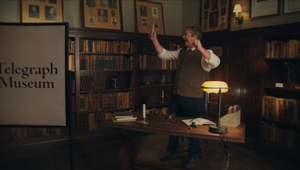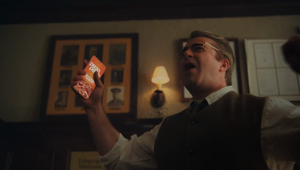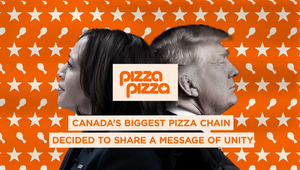
5 Minutes with… Stephanie Yung

A globally-recognised leader in design with over two decades of experience, Stephanie Yung is known for translating brands into products, services and experiences. From the US, to the UK, to Canada – where she presently plies her trade as chief design officer at independent agency Zulu Alpha Kilo – she has collaborated across organisations of all sizes, seeking to uncover hidden opportunities where companies can create positive change in everyday people’s lives.
Someone who lives by a simple ethos, ‘never assume anything’, across the years, Stephanie has built an incredible portfolio, receiving recognition at major award shows including D&AD, Cannes, The One Show, and Fast Company's Innovation by Design. However, equally notable is her work in the mentorship and social good spaces – something which comes in many forms. At Zulu Alpha Kilo, for instance, she guides multi-disciplinary teams through strategy, product development and inclusive design practices on a daily basis. Meanwhile, outside of the office, she’s served as a mentor at The National Foundation for the Advancement of Artists, is a design advisor for Simprints – a not-for-profit tech company looking to close the identification gap of over one billion people in regions marked by poverty – and is an outspoken advocate of designing for women, gender inclusivity, and social impact.
To learn more about such a remarkable career, LBB’s Jordan Won Neufeldt sat down with Stephanie for a chat.
LBB> From the top, how did you get started in the industry? Was design something you always enjoyed growing up?
Stephanie> I always sought out design growing up without ever realising that’s what it was called. When I think about design, I think about details. It’s about the thought, the why. I used to look at movies or storybooks and think, ‘Why does it look this way? Why are they wearing what they’re wearing? Why do they live there and why are they doing what they’re doing?’.
When I was younger, my mother and I used to go to flea markets, and I loved to collect things, looking at the combination of imagery, typography, the materials or tactility of something. I didn’t realise then that those were the things I loved, because it was more about the emotive part of design – the way you can’t necessarily explain why you like it. You just look at it and it makes you feel a certain way.
The other part – the value of which came to me later in life – was the functional aspect of design. Growing up, I always wondered why something was made the way it was. Take an everyday ruler. A measuring ruler is just a flat piece of wood or plastic. A measuring tape is flexible, because you need to measure dimension. When I was in art class, I started using a steel edge ruler, and I thought how interesting the cork on the back of it was. The reason for it is so the ruler doesn’t move. To me, that’s the best design; it’s invisible. So, whenever I’m looking at objects and things like that, or the way things work, I’m always questioning why these things exist.
That path of curiosity led me to university, where I studied English, semiotics, and anthropology. But I realised those weren’t for me, because I wasn’t creating. There’s something about wanting to express a point of view or solve a problem, and I wanted to be able to do that and have people respond to it. That’s what led me to design – the desire for expression and trying to solve a problem. So, I dropped out and went to study design.
LBB> You’ve been designing for well over two decades now – what’s kept the craft fresh and interesting for you? And, how has both your approach, and the industry itself, evolved in that time?
Stephanie> Craft, as a practice, is always a pursuit. ‘Is it good enough? Is it the best it can be?’ – that’s what craft is to me. That hasn’t changed. But, I used to think about craft as perfectionism. Now, I think it’s so much more. It’s intentionality in every single decision you make, and the unwavering commitment to that.
Noticing the changes in the industry, I think AI has made it much easier to create a polished look, which a lot of people deem as craft. But, the origin of ‘craft’ is made by hand, and it’s hard to not think about the idea of a person behind it, as well as the desire to be able to see that as a viewer or participant where you can’t replicate the human touch. I do feel there’s still value to that.
LBB> As part of this, you’ve worked in multiple international markets. How has your approach varied to the needs of each one, if at all? And what makes Zulu Alpha Kilo the right place to call home today?
Stephanie> Who you’re trying to reach changes. But what’s similar across everything is how crucial it is to understand who you’re designing for. What motivates them? What are their needs? What are their pain points, gaps, or barriers? You also need to understand the cultural context. Something that might not be a problem in North America might be a real problem somewhere else. You have to have empathy for who you’re designing for.
Zulu Alpha Kilo (ZAK) is the right place to call home today, largely because of the people. I came to work here because of the belief in fighting sameness, and in the power of creativity to solve real business and human problems. The fact that it’s an independent agency with a great track record is incredibly appealing.
There’s also a level of respect for people here. To be able to have a family and balance creating great work with having a life is a big deal. ZAK understands that people have lives, and it’s not that we don’t work any less or not as hard. But people, and what they’re trying to build, are really valued.
LBB> Building on this, what are your main aims and ambitions for the agency’s design practice? How are you working to ensure brands are strategically translated into products, services and experiences in the most effective manner possible?
Stephanie> First is to create positive change. It doesn't always have to be lofty; it could be moments of joy. People think of design as a strictly visual and aesthetic thing. It's important to understand and create a vibe, of course, because that’s more intangible and harder to replicate. But, the overall experience and long-term impact – the value it adds to people’s lives – is what I'm interested in.
In action, never assume anything. It’s all about the people: your clients, your own agency team, and those you’re designing for. You need to understand your clients’ business and operational models, because if you really want to change things, you have to know if they can actually implement your idea. Problems are much more complex these days, and you can’t just be one designer trying to fix it on your own. You really do need all the different diverse skill sets of your team to come together and problem solve, and the client resources to act on it.
LBB> With that in mind, how would you describe your leadership style? What factors have played the biggest influence on this?
Stephanie> I’m adaptive and flexible. Each designer has their own way of working, and something unique that drives them to get out of bed every morning. To bring out the best in a designer and help them grow, you have to understand what makes them individually tick, and then create a clear path forward for them.
I think, like most people, you probably have good managers and not good managers. I’ve learned from all of those experiences what kind of leader I do and don’t want to be.
LBB> You’re also known for valuing mentorship – why is this so important to you? How do you help develop talent around you on a day to day basis?
Stephanie> I love design, and I need to know that there is a future for it and in it. Developing talent around me is all about paying attention, being proactive, and having open dialogue. I look at a designer beyond just the project we’re working on together and further out to their career, making sure we’re tracking their goals and they are growing their skill set and capabilities to get there. I think it’s really important to make room for conversations and to give feedback as we go – both positive reinforcement and areas for improvement. If somebody does a good job, it’s important to say so in the moment and not wait for their review.
LBB> Since starting in adland, you’ve also become known for your ethos: ‘never assume anything’. What does this mean to you, and why is this such a foundational part of the way you work?
Stephanie> It’s arrogant to think you know everything. Only through curiosity, without any preconceived notions, can you truly arrive at a new place. That’s why children are sometimes the most brilliant problem solvers or creators. They don’t have two decades of experience to draw upon; they look at things in such a fresh way.
LBB> With all that in mind, how would you describe your own style? And what are your ultimate aims in terms of design craft?
Stephanie> I honestly don’t think I have a style, per se. It’s entirely dependent on the point of view I’m trying to communicate, and the brands I’m lucky enough to represent. It’s so intrinsic that I can’t really describe it.
My aims in terms of design craft are to have thoughtfulness in every step, from the insight all the way to final production, to create things that are undeniably well-crafted and make you feel something or take notice, and are exactly what they should be. There are no words for that – great design makes you feel.
LBB> What are some of the best examples from your career which you think reflect this? Why are they significant to you?
Stephanie> ‘The Micropedia of Microaggressions’ was significant in that it was creating a tool in the world that didn’t exist, which people could use, learn from and change their behaviours to become more empathetic and self-aware.
‘Splash Spots’ was another I loved because it was product design, which I have a soft spot for. It was about bringing joy, as well as solving the real problem of water waste, and was just a fun, simple design.
‘Hullo Ferries’ looked at creating a brand behaviour and experience from scratch, from naming to designing different touchpoints across the entire customer experience, including the exterior and interior vessel design.
Finally, I worked with a nonprofit, Upstream, to close the gap in birth control method awareness and empower people to make their own birth control decisions. We worked to redesign the counselling experience by meeting and co-creating with HCPs and patients from across the US to provide the tools to facilitate conversations with people searching for birth control options. That was really meaningful to me; creating behavioural change that was measurable.
LBB> Of course, work isn’t everything. Artistically, where do you look for inspiration? What gets Stephanie’s brain ticking?
Stephanie> I get inspiration just going through life – everyday interactions, sightings, or experiences that make me go, ‘Oh, that’s cool’. So, my eyes and ears are my inspiration.
I came across a Substack post from Rick Rubin about tuning yourself to the moments of awe. It was all about seeking out and sitting with moments that pull you beyond the ordinary. It could come from nature, music, art, or small details of everyday life like… a magnificent sunset? An unusual eye colour? A beautiful melody? Or even something simple like how nicely a package opens up. But, it’s all about noticing everything around you. It really stuck with me – you want to expose yourself to many of the small things that spark joy, creativity or inspiration throughout your day and take note.
LBB> Finally, what helps you de-stress after a long day on set or at the office?
Stephanie> Silence or stillness. I have so much stimuli throughout my day that recharging time is a necessity as a palette cleanser or reset of sorts!















